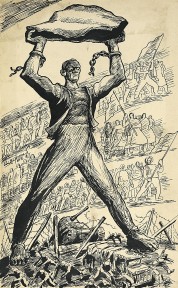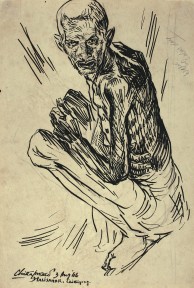‘In my art work, I represent the tradition of moralists and political reformers. To save people means to save art itself. The activity of an artist means the active denial of death.’ – Chittaprosad, in the film Confession, made by Pavel Hobl of Czechoslovakia
Very few gallerists can take the chances that Ashish Anand of Delhi Art Gallery does. While most of his contemporaries find it sufficient to rotate a few canvases of blue chip artists who attract immediate attention, Anand has time and again exhibited comprehensive collections of Indian contemporary art’s unsung heroes – Jyoti Bhatt, Rabin Mondal, Khemraj, Haren Das to name a few – and done this without a care about being able to sell lesser known names.
It is not surprising, therefore, that at a time when the same art frat that ignored Husain’s non-inclusion in consecutive Art Summits is mouthing empty tributes – as many as five shows on Husain have been hosted in the last one month – the gallery has put up the first retrospective ever on the life and work of Chittaprosad, one of India’s most important but rarely celebrated artists.
“Though Chittaprosad is best known for his body of work on the Bengal famine, like me, you will probably be surprised by the extensiveness of his oeuvre, his willingness to constantly experiment, and remain oblivious to the demands of the market,” says Ashish Anand.
Chittaprosad recorded pivotal political and social movements in the country, such as the Great Bengal Famine of 1943-44 and its fallout in heart-wrenching sketches and drawings, alongside protests against colonialism, economic exploitation, urban poverty and depravity, just as beautifully as the many drawings, linocuts and scraper board illustrations he made for children, recording a beatific phase of plenitude and family values, and involving himself with marionettes for their entertainment.
The show celebrates Chittaprosad’s triumph over the circumstances of his highly principled life which he devoted completely to art, rejecting market forces to communicate a truth that was unequivocally his.
The exhibition has been designed in a manner that includes his drawings, paintings, linocuts and other prints, his writings in original, his letters, published writings and drawings in People’s War and People’s Age, among others, manuscripts, posters, puppets and photographs. The social and political relevance of his works resonates as powerfully – and is just as pertinent – today, as it was then.
This retrospective show is accompanied by five seminal books comprehensively researched by art-historian Dr Sanjoy Kumar Mallik, the first two focusing on the artist’s art and life, a third consisting of his political sketches, the fourth being the letters he wrote to friends and family that shed light on his career, his art practice, his interests in literature and cinema, and in people, politics and nature. A fifth book reproduces in full the only surviving copy of Hungry Bengal, all copies of which were seized and burnt by the British when it was originally published by Chittaprosad in 1943.
“What was most memorable in Chitta’s paintings were the eyes. The faces in all his drawings had very large expressive eyes that were mascara-ed with black kajol (kohl), making them appear even larger. Even in his self-portrait, and for all the women and children in his paintings, the eyes were large and filled with the same sadness that he experienced in his own life.” These lines from Sunil Janah, a photographer who travelled with the artist during the Bengal famine, are only a glimpse of the response Chittaprosad’s art can evoke.
As Neville Tuli of Osian’s points out: “Few artists have sustained the heroic battle of living with that rare creative balance where the all-consuming compassion of a noble heart with its social conscience and public service dances daily with the fearlessness of one’s artistic imagination and its critical duty to make aware, to provoke, to make ashamed, to delight.”
Chittaprosad – A Retrospective (1915-1978) will be on at Delhi Art Gallery, 11, Hauz Khas Village, New Delhi, till August 20, 2011, from 11 am to 7 pm (Sunday closed).
It will then move to Kolkata’s Birla Academy of Art & Culture,
August 30 to September 11, 2011.
In addition to the exhibition, the retrospective contains comprehensive material on Chittaprosad, and the film ‘Confession’ will be regularly screened.
Poonam Goel is a freelance journalist and has covered the arts for over 15 years. She contributes on visual arts for various newspapers, magazines and online media. More about her on Story Wallahs. Write to her @
poonamgoel2410@gmail.com








i wish mumbai has an exhibition of comrade chitta’s work too